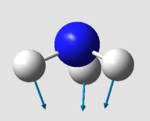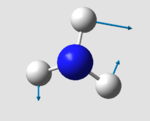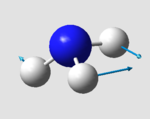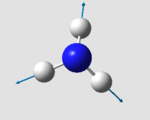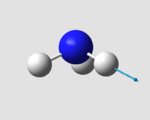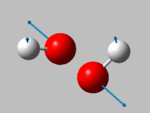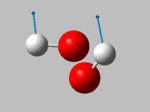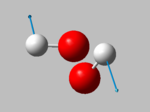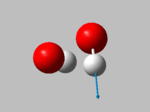Rep:Mod:THL3318
NH3 molecule
Summary
Calculation Method: RB3LYP
Basis Set: 6-31G(d,p)
Final energy E(RB3LYP): -56.55776873 au
Point Group: C3V
Item Value Threshold Converged? Maximum Force 0.000004 0.000450 YES RMS Force 0.000004 0.000300 YES Maximum Displacement 0.000072 0.001800 YES RMS Displacement 0.000035 0.001200 YES
NH3 molecule |
Optimized N-H bond distance = 1.02Å
Optimized H-N-H bond angle = 106°
Link to the NH3 optimization file can be found here.
Vibrations
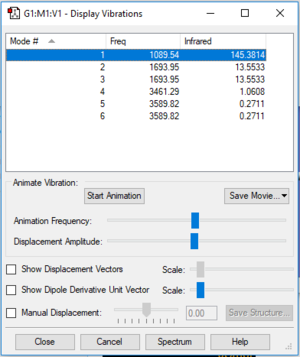
Questions
- How many modes do you expect from the 3N-6 rule?
We would expect 6 vibrational modes because there are 4 atoms in NH3, therefore 3(4)-6=6.
- Which modes are degenerate (ie have the same energy)?
Modes 2,3 and 5,6 are degenerate because they have the same frequency and IR intensity.
- Which modes are "bending" vibrations and which are "bond stretch" vibrations?
Modes 1,2,3 are bending vibrations (change in angle) while modes 4,5,6 are bond stretch vibrations (change in bond length).
- Which mode is highly symmetric?
Mode 1 and 4 are highly symmetric.
- One mode is known as the "umbrella" mode, which one is this?
Mode 1 looks like the opening and closing of an umbrella and would therefore be known as the "umbrella" mode.
- How many bands would you expect to see in an experimental spectrum of gaseous ammonia?
There are 4 distinct wavenumbers but only 3 have a non-zero intensity, therefore we would expect 3 bands to be present in the experimental spectrum of gaseous ammonia.
Charge Distribution
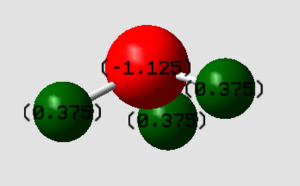
Results: Charge Distribution on Hydrogen atom is 0.375 and -1.125 on Nitrogen
Expectation: As expected, the charge distribution on Nitrogen is negative because it is more elctronegative than hydrogen thus drawing electrons closer to the Nitrogen atom.
N2 molecule
Summary
Calculation Method: RB3LYP
Basis Set: 6-31G(d,p)
Final energy E(RB3LYP): -109.52412868 au
Point Group: D∞h
Item Value Threshold Converged? Maximum Force 0.000006 0.000450 YES RMS Force 0.000006 0.000300 YES Maximum Displacement 0.000002 0.001800 YES RMS Displacement 0.000003 0.001200 YES
N2 molecule |
Optimized N-N bond distance = 1.11Å
Link to the N2 optimization file can be found here.
Vibrations

| wavenumber cm-1 | 2457 |
| symmetry | SGG |
| intensity arbitrary units | 0 |
| image | 
|
Charge Distribution
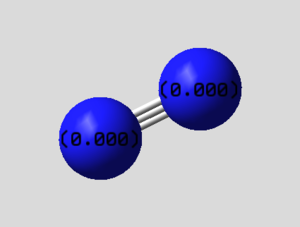
Results: Charge Distribution on Nitrogen atom is 0.0
Expectation: As expected, the charge distribution on Nitrogen is 0 because the electronegativity of both Nitrogen atoms are equal with result in equal sharing of electron density between the two atoms.
H2 molecule
Summary
Calculation Method: RB3LYP
Basis Set: 6-31G(d,p)
Final energy E(RB3LYP): -1.17853930 au
Point Group: D∞h
Item Value Threshold Converged? Maximum Force 0.000211 0.000450 YES RMS Force 0.000211 0.000300 YES Maximum Displacement 0.000278 0.001800 YES RMS Displacement 0.000393 0.001200 YES
H2 molecule |
Link to the H2 optimization file can be found here.
Optimized H-H bond distance = 0.74Å
Vibrations

| wavenumber cm-1 | 4461 |
| symmetry | SGG |
| intensity arbitrary units | 0 |
| image | 
|
Charge Distribution

Results: Charge Distribution on Hydrogen atom is 0.0
Expectation: As expected, the charge distribution on Hydrogen is 0 because the electronegativity of both Hydrogen atoms are equal with result in equal electron density surrounding the atoms.
Mono-metallic TM complex that coordinates N2

CDC of WUQSEH can be found here: [1]
N-N bond length: 1.11Å
The N-N bond length in the crystal structure is equal to the N-N bond length found in an N2 molecule. Using MO theory, we can know that adding electron density to the N-N triple bond would fill up the anti-bonding orbitals. This would result in a decrease in bond length caused by a decrease in bond order as anti-bonding orbitals are filled. In the mono-metallic TM complex shown above, the TM Ir is bonded to 4 substituents, namely a phenyl group, two P atoms bonded to O, and the N-N group. The phenyl group is a very good electron drawing group due to its ring currents. P on the other hand has a very similar electronegativity to Ir. We can therefore presume that the electron density surround the central TM has been mainly shifted towards the phenyl group rather than the N-N group even though N has a higher electronegativity than Ir. As a result the N-N bond length remains unchanged due to no change in electron density
Haber-Bosch process
- E(NH3)= -56.5577687 au
- 2*E(NH3)= -113.1155375 au
- E(N2)= -109.5241287 au
- E(H2)= -1.1785393 au
- 3*E(H2)= -3.5356179 au
- ΔE=2*E(NH3)-[E(N2)+3*E(H2)]= -0.0557909 au = -146.5 KJ/mol (to 1 dp)
The energy for converting hydrogen and nitrogen gas into ammonia gas is -146.5 KJ/mol. Therefore the ammonia product is more stable than the gaseous reactants because it is lower in energy and the overall reaction is exothermic.
Project Molecule (ClF5)
Summary
Calculation Method: RB3LYP
Basis Set: 6-31G(d,p)
Final energy E(RB3LYP) in au: -958.98366404
Point Group: C4V
Item Value Threshold Converged? Maximum Force 0.000075 0.000450 YES RMS Force 0.000018 0.000300 YES Maximum Displacement 0.000231 0.001800 YES RMS Displacement 0.000080 0.001200 YES
ClF5 molecule |
Optimized Cl-F(axial) bond distance = 1.65Å
Optimized Cl-F(equatorial) bond distance = 1.70Å
Optimized F(axial)-Cl-F(equatorial) bond angle = 86°
Optimized F(equatorial)-Cl-F(equatorial) bond angle = 90°
Link to the ClF5 optimization file can be found here.

| Mode Number | 1 | 2 | 3 | 4 | 5 | 6 |
| wavenumber cm-1 | 259 | 280 | 280 | 347 | 452 | 452 |
| symmetry | B2 | E | E | B1 | E | E |
| intensity arbitrary units | 0 | 0 | 0 | 0 | 0 | 0 |
| image |  |
 |
 |
 |
 |

|
| Mode Number | 7 | 8 | 9 | 10 | 11 | 12 |
| wavenumber cm-1 | 471 | 521 | 560 | 734 | 804 | 804 |
| symmetry | A1 | B2 | A1 | A1 | E | E |
| intensity arbitrary units | 28 | 0 | 7 | 75 | 404 | 404 |
| image | 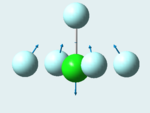 |
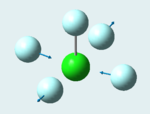 |
 |
 |
 |
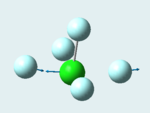
|
Charge Distribution

Results: Charge Distribution on Chlorine is 1.998 and -0.335 on Fluorine. Expectation: As expected, the charge distribution on Fluorine is more negative because it is more elctronegative than Chlorine thus drawing electrons closer to the Fluorine atoms.
Molecular Orbitals
(Independence) H2O2 molecule
Summary
Calculation Method: RB3LYP
Basis Set: 6-31G(d,p)
Final energy E(RB3LYP): -151.54319138 au
Point Group: C2
Item Value Threshold Converged? Maximum Force 0.000075 0.000450 YES RMS Force 0.000038 0.000300 YES Maximum Displacement 0.000349 0.001800 YES RMS Displacement 0.000381 0.001200 YES
H2O2 molecule |
Optimized O-O bond distance = 1.46Å
Optimized O-H bond distance = 0.97Å
Optimized H-O-O bond angle = 100°
Link to the H2O2 optimization file can be found here.
Vibrations
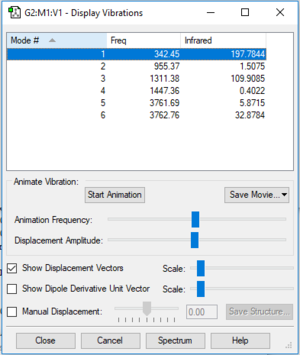
Charge Distribution
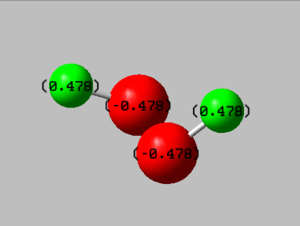
Results: Charge Distribution on Hydrogen atoms is 0.478 and -0.478 on the Oxygen atoms.
Expectation: As expected, the charge distribution on Oxygen more negative than that on Hydrogen because the electronegativity of Oxygen is greater thus resulting in the electron density being around oxygen more than hydrogen.
Marking
Note: All grades and comments are provisional and subject to change until your grades are officially returned via blackboard. Please do not contact anyone about anything to do with the marking of this lab until you have received your grade from blackboard.
Wiki structure and presentation 1/1
Is your wiki page clear and easy to follow, with consistent formatting?
YES
Do you effectively use tables, figures and subheadings to communicate your work?
YES
NH3 1/1
Have you completed the calculation and given a link to the file?
YES
Have you included summary and item tables in your wiki?
YES
Have you included a 3d jmol file or an image of the finished structure?
YES
Have you included the bond lengths and angles asked for?
YES
Have you included the “display vibrations” table?
YES
Have you added a table to your wiki listing the wavenumber and intensity of each vibration?
YES
Did you do the optional extra of adding images of the vibrations?
YES
Have you included answers to the questions about vibrations and charges in the lab script?
YES - mode 4 is too low in energy as well to be detected in an experimental spectrum, so only 2 bands will be seen.
N2 and H2 0.5/0.5
Have you completed the calculations and included all relevant information? (summary, item table, structural information, jmol image, vibrations and charges)
YES
Crystal structure comparison 0.5/0.5
Have you included a link to a structure from the CCDC that includes a coordinated N2 or H2 molecule?
YES
Have you compared your optimised bond distance to the crystal structure bond distance?
YES
Haber-Bosch reaction energy calculation 1/1
Have you correctly calculated the energies asked for? ΔE=2*E(NH3)-[E(N2)+3*E(H2)]
YES
Have you reported your answers to the correct number of decimal places?
YES
Do your energies have the correct +/- sign?
YES
Have you answered the question, Identify which is more stable the gaseous reactants or the ammonia product?
YES
Your choice of small molecule 4/5
Have you completed the calculation and included all relevant information?
YES
Have you added information about MOs and charges on atoms?
YES
You could have analysed the calculated vibrations as you did for NH3.]You correctly identified contributing AOs. The second displayed MOs is rather non-bonding if only the 22p orbital is considered to participate. When taking small contributions of the the F s orbitals into account this orbital could be described as a bonding one. You haven't stated the number of the last MO, so it cannot be identified and therefore not checked if your analysis is correct. I compared all MOs up to number 50 with yours and couldn't figure out which one it is. You could have explained and analysed the relative energies of the MOs in more detail.
Independence 1/1
If you have finished everything else and have spare time in the lab you could:
Check one of your results against the literature, or
Do an extra calculation on another small molecule, or
YES
Do some deeper analysis on your results so far

